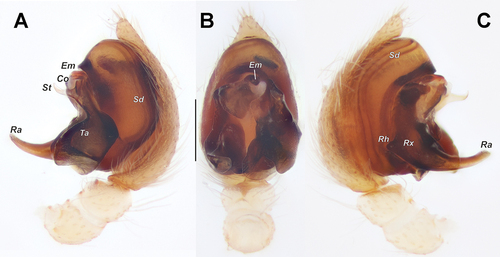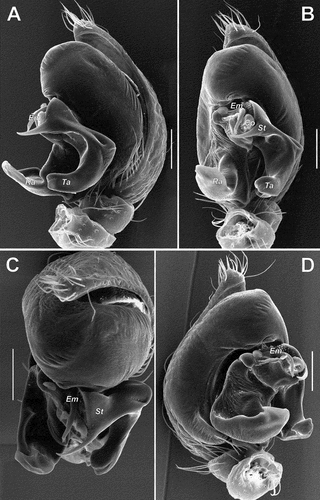ABSTRACT
New data on the oecobiid spiders of the genus Oecobius Lucas, 1846 occurring in Iran and Azerbaijan are provided. Five species are described as new to science: O. dariusi sp. n. (♀; Alborz and Tehran ‒ northern Iran), O. melanocephalus sp. n. (♀; Lorestan, Razavi Khorasan, Semnan, and Tehran ‒ south-western, northern and north-eastern Iran; hitherto described as the female of O. ferdowsii Mirshamsi, Zamani and Marusik, 2017), O. naxuanus sp. n. (♂; Nakhchivan ‒ western Azerbaijan), O. pasargadae sp. n. (♂♀; Fars ‒ south-central Iran), and O. zagros sp. n. (♂; Kermanshah ‒ western Iran). Furthermore, O. navus Blackwall, 1859 is reported in Iran for the first time, and new distribution records are provided for O. putus O. Pickard-Cambridge, 1876 and O. nadiae (Spassky, 1936).
http://www.zoobank.org/urn:lsid:zoobank.org:pub:98E34233-D62C-4443-A963-6F1DFB6183DF
KEYWORDS:
Introduction
Oecobius Lucas, 1846, the largest genus of the spider family Oecobiidae, has an almost global distribution and currently comprises 90 species, as well as one fossil species from Dominican amber (Dunlop et al. Citation2020; WSC Citation2023). Although it is the most species-rich oecobiid genus, no species-group divisions have been proposed for it, except for the species found in the Canary Archipelago, where the genus has the highest species diversity – 41 species (Wunderlich Citation1987). These species were categorised into three species groups, with just one, the navus group, being non-endemic to the archipelago. Although a worldwide revision of this genus has never been undertaken, it is relatively well studied within specific regions, particularly in the Nearctic (Shear Citation1970), as well as areas in the Mediterranean region, e.g. the Canary Islands, Madeira, and the East Mediterranean (Wunderlich Citation1987, Citation1992, Citation1995). Wunderlich has described 49 species (WSC Citation2023), which accounts for over half of the presently recognised species of Oecobius. Only four of his described species have been later synonymised. Besides the Mediterranean region, only Iran has been the subject of several publications dealing with Oecobius (e.g. Zamani et al. Citation2017; Zamani and Marusik Citation2018; Zamani and Bosselaers Citation2020), resulting in six species currently known from this country (including two endemics). However, the fauna of the adjacent Caucasus remains relatively poorly studied, with only five species currently known from the region, all of which have wide distributions (Otto Citation2022). In this paper, we contribute to the knowledge of the diversity of this genus in Iran and the Caucasus by providing descriptions of five new species and recording one species that is new to Iran.
Material and methods
Photographs were obtained using an Olympus Camedia E‐520 camera attached to an Olympus SZX16 stereomicroscope, and a JEOL JSM-5200 scanning electron microscope at the Zoological Museum of the University of Turku. Digital images of different focal planes were stacked with Helicon Focus™ 8.1.1. Illustrations of the vulvae were made after digesting tissues off in a 10% potassium hydroxide (KOH) aqueous solution. Leg segments were measured on the dorsal side. Measurements of legs are listed as: total length (femur, patella, tibia, metatarsus, tarsus). All measurements are given in millimetres. The map () was prepared using SimpleMappr (Shorthouse Citation2010).
Abbreviations: Eyes: ALE ‒ anterior lateral eye, AME ‒ anterior median eye, PLE ‒ posterior lateral eye, PME ‒ posterior median eye.
Depositories: AZMI – Agricultural Zoology Museum of Iran, Tehran, Iran (A. Khaleghizadeh); MHNG – Muséum d’histoire naturelle, Genève, Switzerland (L. Monod); MMUE – Manchester Museum of the University of Manchester, United Kingdom (D.V. Logunov); ZMFUM – Zoological Museum of the Ferdowsi University of Mashhad, Iran (O. Mirshamsi); ZMMU – Zoological Museum of the Moscow State University, Russia (K.G. Mikhailov); ZMUT – Zoological Museum of the University of Turku, Finland (V. Vahtera); ZUCT – Zoological Collection of the University of Tehran, Iran.
Family OECOBIIDAE Blackwall, 1862
Genus Oecobius Lucas, 1846
Type species
Oecobius domesticus Lucas, 1846, a junior synonym of O. cellariorum (Dugès, 1836).
Oecobius dariusi sp. n.
()
Type material
Holotype ♀ (ZMMU), IRAN: Tehran Province: 80 km E of Tehran, Damavand, Aroo Vil., 35.666667°N, 52.45°E, 15 June 2000 (Y.M. Marusik). Paratypes: 3♀ (ZMMU), 3♀ (MMUE), same data as for the holotype; 2♀ (ZMUT), Alborz Province: Sardor area, 10 km N of Karaj, 30.833333°N, 51.083333°E, 13 June 2000 (Y.M. Marusik).
Etymology
This species is named after Darius I, who is more commonly known as Darius the Great. He was the third King of Kings of the Achaemenid Empire and reigned from 522 BCE until his death in 486 BCE. During his rule, the empire reached its territorial peak.
Diagnosis
In the shape of the epigyne, the new species resembles O. latiscapus Wunderlich, Citation1992, known only from Tenerife. Both species have a wide ‘scape’ (Sc), a character unknown in the congeners. The new species can be distinguished by the heavily sclerotised tip of scape (vs not sclerotised) and by having many arched wrinkles in the anterior half and three posteriorly to the ‘scape’ (vs numerous straight wrinkles posteriorly from the ‘scape’), and a few straight wrinkles anteriorly from the ‘scape’ (compare Figure 2A–C and Wunderlich Citation1992, fig. 283). The vulva of O. latiscapus has never been illustrated, and therefore cannot be compared with that of the new species.
Description
Female (holotype). Habitus as in . Total length 3.60. Carapace 0.83 long, 1.09 wide. Eye sizes: AME: 0.08, ALE: 0.09, PLE: 0.06, PME: 0.10. Carapace light yellowish brown, with darker median pattern and marginal stripes. Chelicerae, sternum, labium, and maxillae pale brown. Legs coloured as carapace, with broad annulations. Abdomen greyish brown and mottled with small guanine patches, dorsally with dark brown median pattern and marginal stripe. Spinnerets light greyish brown. Measurements of legs: I: 3.74 (1.02, 0.43, 0.78, 0.85, 0.66), II: 3.96 (1.09, 0.42, 0.83, 0.95, 0.67), III: 3.85 (1.07, 0.40, 0.84, 0.98, 0.56), IV: 4.02 (1.13, 0.41, 0.89, 1.02, 0.57).
Figure 1. Habitus of Oecobius dariusi sp. n. (A), O. naxuanus sp. n. (B), O. pasargadae sp. n. (C, D), O. navus (E, F), O. melanocephalus sp. n. (G, H) and O. zagros sp. n. (I), in dorsal (A–G, I) and ventral (H) views. A, D, F, G, H, females; B, C, E, I, males. G, H reproduced from Zamani et al. (Citation2017). Scale bars = 0.5 mm.

Epigyne as in ; epigynal plate ca as wide as long, with large scape in centre ca 0.4 of width of plate; ‘scape’ (Sc) wider than long, with rounded tip, anterior 2/3 with arched wrinkles (ca 10), posterior 1/3 with ca 3 arched wrinkles; receptacles (Re) large oval, 2 times longer than wide, ca 1.1 times longer than epigynal plate; copulatory ducts short; sclerotised capsules (Cs) round, contiguous, located posteriorly.
Figure 2. Epigyne of Oecobius dariusi sp. n. (A) intact, ventral; (B) macerated, ventral; (C) cleared, ventral; (D), (E) dyed, dorsal and posterior. Scale bars = 0.2 mm. Abbreviations: Cs – sclerotised capsule, Re – receptacle, Sc – ‘scape’.
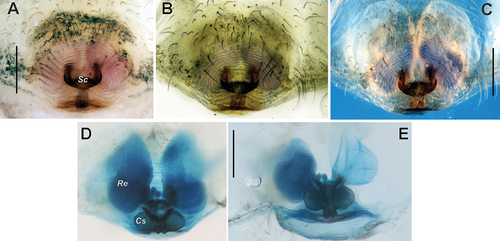
Male
Unknown.
Distribution
Known only from the listed localities in Alborz and Tehran provinces, northern Iran ().
Oecobius melanocephalus sp. n.
()
Oecobius ferdowsii: Zamani et al. Citation2017: 333, fig. 3A‒D (♀). – Zamani and Bosselaers Citation2020: 42, fig. 3A (♀).
Type material
Holotype ♀ (ZMFUM), IRAN: Razavi Khorasan Province: Mashhad, 36.383333°N, 59.383333°E, 20 June 2015 (M. Hatami) [mismatched paratype of O. ferdowsii].
Additional material examined
IRAN: Tehran Province: 1♀ (AZMI), Varamin-Pakdasht Rd., wheat field, Water Pump station, 16 April 2001 (A. Bahramishad); Lorestan Province: 1♀ (MHNG), Ma’mulan, 33.377778°N, 47.960417°E, 6 August 1973 (A. Senglet); 1♀ (MHNG), Tang-e-Malavi, 33.263361°N, 47.76225°E, 24 June 1974 (A. Senglet); Semnan Province: 1♀ (ZUCT), road to Shahrud, 36.306417°N, 54.794722°E, 17 May 2016 (A. Zamani).
Etymology
The specific epithet refers to the characteristic black colouration of the carapace in this species.
Diagnosis
The new species differs from all its congeners occurring in the region, except for O. rhodiensis Kritscher, 1966, by having a uniformly dark carapace. The new species differs from O. rhodiensis by dark sternum and venter of abdomen (vs light). The epigyne of the new species is somewhat similar to that of O. fahimii Zamani and Marusik, Citation2018 in the similar position of the sclerotised capsules, but differs by a relatively longer posterior part of ‘scape’ (Sc), ‘hoods’ (H) longer than scape is wide, and round sclerotised capsules (Cs) (vs ‘scape’ wider than ‘hoods’, sclerotised capsules oval; see ).
Figure 3. Epigynes of Oecobius melanocephalus sp. n. (A, B) and O. fahimii (C, D). (A) intact, ventral; (B) macerated, dorsal; (C), (D) dyed, dorsal. Scale bars = 0.2 mm. (A), (B) reproduced from Zamani et al. (Citation2017). (C), (D) reproduced from Zamani and Marusik (Citation2018). Abbreviations: Cs – sclerotised capsule, H – ‘hood’, Re – receptacle, Sc – ‘scape’.
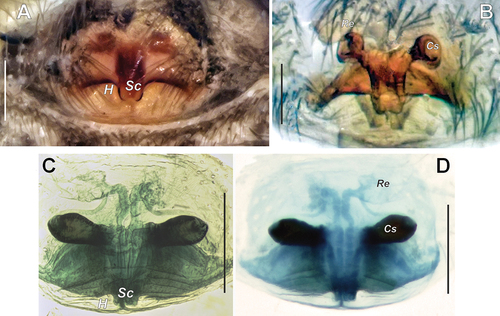
Description
Female (measurements from Zamani et al. Citation2017, p. 335). Habitus as in . Total length 2.58. Carapace 0.88 long, 1.00 wide. Eye sizes: AME: 0.08, ALE: 0.09, PLE: 0.04, PME: 0.13. Carapace and sternum uniformly black. Chelicerae, labium, and maxillae dark brown. Legs pale yellowish brown, with distinct annulations. Abdomen black, dorsally mottled with guanine patches and bearing black median band and submedian patches, ventrally slightly lighter, with three light brown longitudinal stripes. Spinnerets slightly lighter than abdomen, uniformly coloured. Measurements of leg I: 2.77 (0.78, 0.28, 0.56, 0.62, 0.53).
Epigyne as in ; epigynal plate oval, ca 1.3 times wider than long; with distinct, as long as wide ‘scape’ (Sc), and pair of ‘hoods’ (H), twice wider than ‘scape’; sclerotised capsules (Cs) round, separated by ca 3 diameters; receptacles (Re, poorly distinct in ) oval, transversal, each shorter than half of epigynal plate width.
Male
Unknown.
Distribution
Known from Lorestan, Tehran, Semnan and Razavi Khorasan provinces, south-western to north-eastern Iran ().
Comments
This species was initially described as the female of O. ferdowsii Mirshamsi, Zamani and Marusik, Citation2017. This is herein considered a mismatch: not only are there striking differences in the colouration pattern between the two species (compare Zamani et al. Citation2017, fig. 2A, B and 3A, B), but the results of ongoing research on Central Asian Oecobiinae also indicate that O. ferdowsii should be classified within a separate genus. The females of this currently undescribed genus exhibit a completely different conformation of epigyne and vulva compared to those of O. melanocephalus sp. n.
Oecobius nadiae (Spassky, Citation1936)
Uroctea nadiae Spassky, Citation1936: 43, figs 7–9 (♂♀).
Oecobius afghanicus Kullmann and Zimmermann, Citation1976: 42, figs 1–3, 6–9, 12, 13 (♂♀).
Oecobius nadiae: Zarikian et al. Citation2022: 112, fig, 7A–D (♀).
For the full list of 13 taxonomic entries see the World Spider Catalog (WSC Citation2023).
Material
IRAN: Tehran Province: 1♂1♀ (ZMMU), Iranian Research Institute of Plant Protection, 35.783333°N, 51.4°E, 7‒22 June 2000 (Y.M. Marusik).
Records in Iran
Isfahan, North Khorasan, Razavi Khorasan, South Khorasan, Tehran, Zanjan (Zamani et al. Citation2015, Citation2018; Sadeghi et al. Citation2016; Zamani Citation2016; Alimohammadi and Moradmand Citation2021; present material).
Distribution
Armenia to China (Xinjiang, Sichuan) (WSC Citation2023).
Oecobius navus Blackwall, 1859
()
Oecobius annulipes: Baum Citation1972: 117, figs 17–19, 50–53, 62 (♂♀).
Oecobius navus: Wunderlich Citation1995: 595, figs 31–35 (♂♀).
For the full list of 69 taxonomic entries see WSC (Citation2023).
Material
IRAN: Mazandaran Province: 1♂ (ZMMU), Nashtarud, 36.733333°N, 51.066667°E, 9‒10 June 2000 (Y.M. Marusik); 2♀ (ZMMU), Ramsar, 36.916667°N, 50.666667°E, 10 June 2000 (Y.M. Marusik).
Comments
This species differs from the congeners occurring in the region by the dark lateral patches on clypeus, three pairs of sublateral dots on carapace (indistinct in some specimens), and the presence of dots on legs (but not annulations). We noted that it has a kind of retrolateral tibial apophysis (arrowed in ), which has not been previously documented.
Figure 4. Copulatory organs of Oecobius navus. (A) male palp, retrolateral; (B) same, ventral; (C) same, prolateral; (D) intact epigyne, ventral. (C), (D) reproduced from Zamani and Marusik (Citation2018). Arrow points to the tibial apophysis. Scale bars = 0.2 mm.
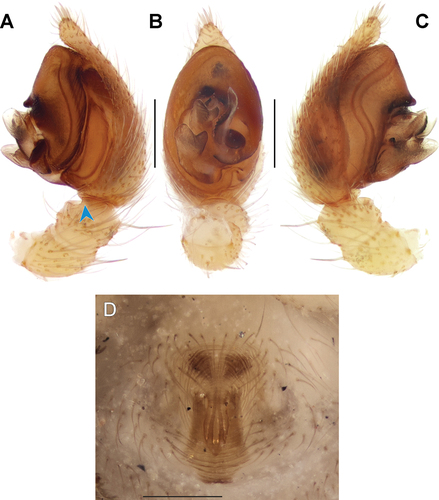
Distribution
West Palaearctic. Introduced in South Africa, China, Korea, Japan, New Zealand, Canada, USA, South America (WSC Citation2023). New record for Iran ().
Oecobius naxuanus sp. n.
()
Type material
Holotype ♂ (ZMMU), AZERBAIJAN: Nakhchivan Autonomous Republic: Dasharkh Vil., 39.55°N, 45.033333°E, 1‒4 June 2003 (Y.M. Marusik).
Etymology
The specific epithet refers to Naxuana, which is the name given to Nakhchivan in Ptolemy’s Geography and in the works of other classical authors.
Diagnosis
In the habitus, the new species is similar to O. dariusi sp. n., but differs by having no annulations on the legs (compare ). In the general conformation of the male palp and particularly the shape of radical apophysis, it is similar to O. rhodiensis (compare and Demir et al. 2009, figs 11, 12, 14, 15), but can be distinguished by the gradually tapering and gently bent radical apophysis (Ra) (vs tip not tapering and bent; compare and Wunderlich Citation1995, fig. 49).
Description
Male
Habitus as in . Total length 2.17. Carapace 0.75 long, 0.88 wide. Eye sizes: AME: 0.08, ALE: 0.08, PLE: 0.06, PME: 0.09. Carapace yellowish brown, with darker radiating and marginal stripes. Chelicerae, sternum, labium, and maxillae pale brown. Legs coloured as carapace, without annulations. Abdomen greyish brown and mottled with small guanine patches, with dark brown patches. Spinnerets light greyish brown. Measurements of legs: I: 2.79 (0.82, 0.30, 0.61, 0.60, 0.46), II: 2.98 (0.86, 0.32, 0.68, 0.63, 0.49), III: 2.97 (0.82, 0.31, 0.66, 0.69, 0.49), IV: 3.28 (0.95, 0.32, 0.70, 0.81, 0.50).
Palp as in ; bulb oval in ventral view, 1.4 times longer than wide; sperm duct (Sd) not forming loops; terminal apophysis (Ta) broad in lateral view, with 2 lobes; subterminal apophysis (St) hook-like, bent anteriorly; radix (Rx) with long, roundly bent apophysis (Ra) and kind of heel (Rh); ‘conductor’ (Co) small, membranous; embolus (Em) short and thick.
Female
Unknown.
Distribution
Known only from the type locality in Nakhchivan Autonomous Republic, Western Azerbaijan ().
Oecobius pasargadae sp. n.
()
Type material
Holotype ♂ (MMUE), IRAN: Fars Province: Shiraz, 29.6°N, 52.516667°E, 18‒26 May 2000 (Y.M. Marusik). Paratypes: 1♂4♀ (ZMMU), 4♀ (MMUE), same data as for the holotype.
Etymology
The specific epithet refers to the capital of the Achaemenid Empire under Cyrus the Great, which is nowadays an archaeological site approximately 90 km north-east of Shiraz; noun in apposition.
Diagnosis
In the habitus, the new species differs from all of the congeners occurring in the region by lacking a carapace pattern in combination with lacking leg annulations. Its male can be easily distinguished from the congeners occurring in the region by having a tegular bump (Tb), almost equally long longitudinal terminal (Ta) and radical (Ra) apophyses (vs different in length or not elongate), and by having a kind of tooth (Rt) on the tip of radical apophysis. The female of the new species differs from all other species known in the region by having an arch-shaped notch of the plate (Pc), with the plate bearing copulatory openings (vs plate with extension (‘scape’) bearing copulatory openings).
Description
Male (holotype). Habitus as in . Total length 2.00. Carapace 0.80 long, 0.95 wide. Eye sizes: AME: 0.07, ALE: 0.08, PLE: 0.05, PME: 0.11. Carapace light yellowish brown. Chelicerae, sternum, labium, and maxillae pale brown. Legs coloured as carapace, without annulations. Abdomen greyish brown and mottled with small guanine patches. Spinnerets light greyish brown. Measurements of legs: I: 3.12 (0.90, 0.32, 0.68, 0.68, 0.54), II: 3.18 (0.90, 0.31, 0.72, 0.70, 0.55), III: 3.10 (0.83, 0.31, 0.68, 0.74, 0.54), IV: 3.29 (0.94, 0.29, 0.74, 0.81, 0.51).
Palp as in ; tibia with a kind of retrolateral apophysis (arrowed in ); bulb subtriangular in ventral view; tegulum with ‘bump’ (Tb) in anterior part; sperm duct with small loop (Lo) in anterior part of tegulum; terminal apophysis (Ta) gutter-shaped in retrolateral view, with transverse wrinkles; radix (Rx) with broad radical apophysis (Ra) bearing kind of tooth (Rt) at mesal part.
Figure 6. Copulatory organs of Oecobius pasargadae sp. n. (A) male palp, retrolateral; (B) same, ventral; (C) same, prolateral; (D) intact epigyne, ventral; (E) dyed, ventral; (F) same, dorsal. Arrow points to the tibial apophysis. Scale bars = 0.2 mm. Abbreviations: Cs – sclerotised capsule, Em – embolus, Lo – loop of sperm duct, Pc – plate with copulatory openings, Ra – radical apophysis, Re – receptacle, Rt – tooth of radical apophysis, Rx – radix, Ta – terminal apophysis, Tb – tegular bump.

Female. Habitus as in . Total length 2.80. Carapace 0.74 long, 0.83 wide. Eye sizes: AME: 0.06, ALE: 0.08, PLE: 0.05, PME: 0.09. Colouration as in male. Measurements of legs: I: 2.93 (0.86, 0.30, 0.61, 0.63, 0.53), II: 3.02 (0.82, 0.31, 0.66, 0.69, 0.54), III: 2.89 (0.78, 0.31, 0.62, 0.72, 0.46), IV: 3.18 (0.88, 0.32, 0.73, 0.79, 0.46).
Epigyne as in ; epigynal plate ca 1.3 times wider than long; posterior part with arched notch occupied by kind of plate with copulatory openings (Pc); copulatory ducts terminally fused; sclerotised capsules (Cs) oval, diverging; receptacles (Re) oval transversal (not clearly visible on ).
Distribution
Known only from the type locality in Fars Province, south-central Iran ().
Oecobius putus O. Pickard-Cambridge, 1876
Oecobius putus: Baum Citation1972: 125, figs 31, 32, 58–61, 64 (♂♀).
Oecobius putus: Kullmann and Zimmermann Citation1976: 44, figs 4, 5, 10, 11 (♂♀).
For the full list of 18 taxonomic entries see WSC (Citation2023).
Material
IRAN: Fars Province: 16♂27♀ (ZMMU), Shiraz, 29.6°N, 52.516667°E, 18‒26 May 2000 (Y.M. Marusik); Tehran Province: 2♂4♀ (ZMMU), Iranian Research Institute Iranian Research Institute of Plant Protection, 35.783333°N, 51.4°E, 7‒22 June 2000 (Y.M. Marusik).
Records in Iran
Fars, Hormozgan, Khuzestan, Mazandaran, Tehran (Zamani Citation2016; Zamani et al. Citation2016; Zamani and Mozaffarian Citation2017; Boukan et al. Citation2018; Zamani and Bosselaers Citation2020; Hosseinpour et al. Citation2022; present material).
Distribution
South Africa, Egypt, Cyprus, Sudan to Iran, Azerbaijan, Afghanistan, India. Introduced in USA, Mexico (WSC Citation2023). Synanthropic species.
Oecobius zagros sp. n.
(, , )
Figure 7. Male palp of Oecobius zagros sp. n. (A) retrolateral; (B) ventral; (C), (D) prolateral, slightly different angles. Scale bar = 0.2 mm. Abbreviations: Co – ‘conductor’, Em – embolus, Lo – loop of sperm duct, Ra – radical apophysis, Rx – radix, St – subterminal apophysis, Ta – terminal apophysis.
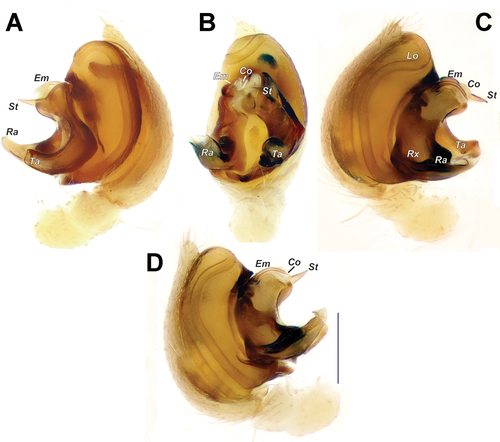
Type material
Holotype ♂ (MHNG), IRAN: Kermanshah Province: Dizgaran, 33.733333°N, 46.983333°E, 16 May 1974 (A. Senglet).
Etymology
The specific epithet is a noun in apposition, referring to a long mountain range in Iran, northern Iraq and south-eastern Turkey, in which the type locality of the new species is situated.
Diagnosis
In the general conformation of the male palp and particularly the shape of radical apophysis, the new species is most similar to O. ilamensis Zamani, Mirshamsi and Marusik, Citation2017, a species so far known only from Ilam Province in western Iran (Zamani et al. Citation2017). The male palp of the new species differs from that of O. ilamensis by having straight, spine-like subterminal apophysis (St) (vs with bent tip) and abrupt tip of terminal apophysis (Ta) (vs finger-shaped) (compare and Zamani et al. Citation2017, fig. 1C).
Description
Male
Habitus as in Figure 1I. Total length 1.65. Carapace 0.60 long, 0.72 wide. Eye sizes: AME: 0.04, ALE: 0.06, PLE: 0.06, PME: 0.08. Carapace yellowish brown, with darker median and marginal stripes. Chelicerae, sternum, labium, and maxillae pale brown. Legs coloured as carapace, with faint annulations. Abdomen greyish brown and mottled with small guanine patches, with dark brown patches. Spinnerets light greyish brown. Measurements of legs: I: 2.27 (0.65, 0.27, 0.48, 0.49, 0.38), II: 2.29 (0.67, 0.25, 0.48, 0.48, 0.41), III: femur 0.67, patella 0.24, rest of the segments missing, IV: 2.56 (0.72, 0.28, 0.54, 0.61, 0.41).
Palp as in ; bulb oval in ventral view, ca 1.7 times longer than wide; sperm duct with small loop (Lo) in anterior part of tegulum; radix (Rx) long, with claw-like apophysis (Ra); subterminal apophysis (St) spine-like; terminal apophysis (Ta) long, with abrupt tip; ‘conductor’ (Co) membranous, as long as wide; embolus (Em) claw-like, almost as long as subterminal apophysis.
Female
Unknown.
Distribution
Known only from the type locality in Kermanshah Province, western Iran (). On the label, the locality is listed as Lorestan Province, while the coordinates refer to another locality in Ilam Province. We consider Dizgaran in Kermanshah to be the correct type locality.
Figure 9. Collection localities of the newly described/recorded species of Oecobius. Circles – O. dariusi sp. n.; stars – O. melanocephalus sp. n.; squares – O. navus; triangle – O. naxuanus sp. n.; hexagon – O. pasargadae sp. n.; inverted triangle – O. zagros sp. n. Yellow symbols indicate the type localities.
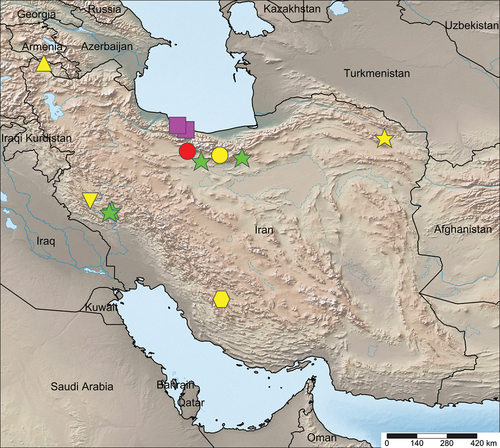
Discussion
Based on the results of this paper, 11 species of Oecobius are known from Iran. Among these, seven species exhibit a similar conformation of the copulatory organs and can be considered to fall within the same species group. These species are as follows: O. cellariorum (Dugès, 1836) [♂♀]; O. fahimii Zamani and Marusik, Citation2018 [♀]; O. ilamensis Zamani, Mirshamsi and Marusik, Citation2017 [♂]; O. melanocephalus sp. n. [♀]; O. pasargadae sp. n. [♂♀]; O. putus O. Pickard-Cambridge, 1876 [♂♀]; O. zagros sp. n. [♂]. It is important to note that while two of these species are currently known only from males and two are known only from females, we do not believe that they are conspecific, due to their different colouration patterns and distribution range. To verify this, however, it is necessary to collect material of both sexes for these four nominal species. The species newly described from Azerbaijan in this paper, O. naxuanus sp. n., also belongs to this species group, and it represents the first endemic species of this genus from the Caucasus (Otto Citation2022).
Each of the remaining four species of Iranian Oecobius represents a distinct species group: O. dariusi sp. n. [♀]; O. ferdowsii Mirshamsi, Zamani and Marusik, Citation2017 [♂]; O. nadiae (Spassky, Citation1936) [♂♀]; O. navus Blackwall, 1859 [♂♀].
The taxonomy of the group comprising O. ferdowsii will be addressed in a separate publication. Prior to this study, O. ferdowsii was thought to have a widespread distribution in Iran, with material collected from several localities in the south-western, northern, and north-eastern parts of the country. However, our research revealed that the females previously attributed to this species were actually misidentified and are therefore described in this paper as a new species (O. melanocephalus sp. n.). Consequently, O. ferdowsii is now confidently known only from Razavi Khorasan Province in north-eastern Iran. The record of this species from Kazakhstan (Fomichev Citation2022) also appears to be based on a misidentification, likely resulting from the lack of illustration of the ventral aspect of the male palp in the original description.
During the preparation of this paper, we discovered an error in two of our previous works involving male specimens of Oecobius (Marusik et al. Citation2015; Zamani et al. Citation2017), and also in Fomichev (Citation2022). Despite using the terminology proposed by Baum (Citation1972), we overlooked that he had depicted the right palps rather than the standard left ones. This oversight led to inaccuracies in identifying the structures of the male palp. Consequently, in those papers, what is originally identified as the radical apophysis is, in fact, the terminal apophysis, and vice versa. Similarly, the designation of the embolus should be attributed to the subterminal apophysis, and vice versa.
Acknowledgements
We thank Lionel Monod and Peter Schwendinger (Geneva, Switzerland) for providing us with the material of Senglet’s collection held in MHNG, and Alexander A. Fomichev (Barnaul, Russia) and an anonymous reviewer for their comments on the manuscript. YMM is grateful to Ilari Eerikki Sääksjärvi and Seppo Koponen for arranging his stay in Turku.
Disclosure statement
No potential conflict of interest was reported by the authors.
Additional information
Funding
References
- Alimohammadi S, Moradmand M. 2021. A study of the spider (Arachnida: Araneae) fauna of the Dalan-Kouh protected area (Isfahan Province, Iran). Taxon Biosyst. 11(41, for 2019):71–84. [in Persian] doi: 10.22108/tbj.2020.124415.1120.
- Baum S. 1972. Zum “Cribellaten-Problem”: die Genitalstrukturen der Oecobiinae und Urocteinae (Arach.: Aran: Oecobiidae). Abh Verh Naturwiss Vereins Hamburg N F. 16:101–153.
- Boukan A, Rajabi R, Oshaghi MA, Rafinejad J, Seyyar O. 2018. A contribution to the knowledge of the spider fauna of Iran (Araneae: Oecobiidae). Serket. 16(1):23–26.
- Dunlop JA, Penney D, Jekel D. 2020. A summary list of fossil spiders and their relatives. World Spider Catalog. Version 20.5. Bern: Natural History Museum Bern; [ accessed 2023 Aug 19]. http://wsc.nmbe.ch.
- Fomichev AA. 2022. First record of the spider Oecobius ferdowsii Mirshamsi, Zamani & Marusik, 2017 (Araneae, Oecobiidae) in Kazakhstan. Check List. 18(1):103–107. doi: 10.15560/18.1.103.
- Hosseinpour A, Jaberhashemi SA, Vahedi M, Soltani A. 2022. New record of spiders (Arachnida: Araneae) from Bashagard district, Southern Iran, with the report of a medically important species. J Trop Med. 2022:9509404. doi: 10.1155/2022/9509404.
- Kullmann E, Zimmermann W. 1976. Beschreibung der neuen Spinnenart Oecobius afghanicus mit ergänzenden Angaben zu Oecobius putus und Oecobius annulipes (Arachnida: Araneae: Oecobiidae). Entomol Ger. 3(1–2):41–50. doi: 10.1127/entom.germ/3/1976/41.
- Marusik YM, Omelko MM, Koponen S. 2015. Redescription of Oecobius tadzhikus Andreeva et Tyshchenko, 1969 (Aranei: Oecobiidae). Arthropoda Sel. 24(2):197–200. doi: 10.15298/arthsel.24.2.05.
- Otto S. 2022. Caucasian Spiders. A faunistic database on the spiders of the Caucasus. Version 02; [ accessed 2023 Aug 19]. https://caucasus-spiders.info/.
- Sadeghi H, Ahmadi M, Zamani A, Jabaleh I. 2016. A study on the spider fauna of Dargaz and Kalat Counties in Razavi Khorasan Province, Iran (Arachnida: Araneae). Biharean Biol. 10(1):4–7.
- Shear WA. 1970. The spider family Oecobiidae in North America, Mexico, and the West Indies. Bull Mus Comp Zool. 140:129–164.
- Shorthouse DP. 2010. SimpleMappr, an online tool to produce publication-quality point maps; [ accessed 2023 Oct 11]. http://www.simplemappr.net.
- Spassky SA. 1936. Araneae palaearcticae novae. Festschrift Embrik Strand. 1:37–46.
- WSC. 2023. World Spider Catalog. Version 24. Natural History Museum Bern; [ accessed 2023 Aug 1]. http://wsc.nmbe.ch.
- Wunderlich J. 1987. Die Spinnen der Kanarischen Inseln und Madeiras: adaptive Radiation, Biogeographie, Revisionen und Neubeschreibungen. Langen: Triops Verlag.
- Wunderlich J. 1992. Die Spinnen-Fauna der Makaronesischen Inseln: taxonomie, Ökologie, Biogeographie und Evolution. Beitr Araneol. 1:1–619.
- Wunderlich J. 1995. Zu Taxonomie und Biogeographie der Arten der Gattung Oecobius Lucas 1846, mit Neubeschreibungen aus der Mediterraneis und von der Arabischen Halbinsel (Arachnida: Araneae: Oecobiidae). Beitr Araneol. 4(1994):585–608.
- Zamani A. 2016. Field guide to the Spiders and Scorpions of Iran. Tehran: Iranshenasi; p. 360. [in Persian]
- Zamani A, Bosselaers J. 2020. The spider family Oecobiidae (Arachnida: Araneae) in Iran, Afghanistan and Turkmenistan. Eur J Taxon. 726:38‒58. doi: 10.5852/ejt.2020.726.1173.
- Zamani A, Marusik YM. 2018. The first report on the spider fauna (Arachnida: Araneae) of the Lut Desert, Iran. Acta Arachnol. 67(2):67‒75. doi: 10.2476/asjaa.67.67.
- Zamani A, Mirshamsi O, Jannesar B, Marusik YM, Esyunin SL. 2015. New data on spider fauna of Iran (Arachnida: Araneae), Part II. Zool Ecol. 25(4):339–346. doi: 10.1080/21658005.2015.1068508.
- Zamani A, Mirshamsi O, Kashani GM, Karami L. 2018. New data on the spider fauna of Iran (Arachnida: Araneae), Part V. Iran J Anim Biosyst. 13(2, for 2017):183–197. doi: 10.22067/ijab.v13i2.72404.
- Zamani A, Mirshamsi O, Marusik YM, Hatami M, Maddahi H. 2017. The spider genus Oecobius in Iran, with description of two new species (Araneae: Oecobiidae). Orient Insects. 51(4):330‒337. doi: 10.1080/00305316.2017.1283257.
- Zamani A, Mirshamsi O, Rashidi P, Marusik YM, Moradmand M, Bolzern A. 2016. New data on the spider fauna of Iran (Arachnida: Aranei), part III. Arthropoda Sel. 25(1):99–114. doi: 10.15298/arthsel.25.1.10.
- Zamani A, Mozaffarian F. 2017. Further spider (Arachnida: Araneae) material deposited in the agricultural zoology museum of Iran (AZMI), Iranian research institute of plant protection. Arachnol Mitt. 54:8–20. doi: 10.5431/aramit5403.
- Zarikian NA, Propistsova EA, Marusik YM. 2022. On spider families (Arachnida: Araneae) new to Armenia. Isr J Entomol. 51(2021):103–117. doi: 10.5281/zenodo.6466083.

